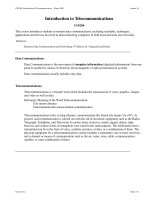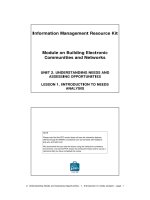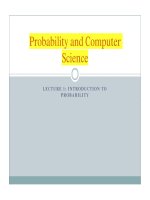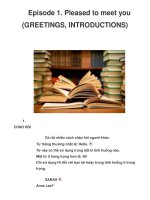lecture 1 intro to food analysis
Bạn đang xem bản rút gọn của tài liệu. Xem và tải ngay bản đầy đủ của tài liệu tại đây (66.68 KB, 7 trang )
1
FOOD ANALYSIS
BTFT302IU
PHAM VAN HUNG, PhD
Department of Food Technology
School of Biotechnology, IU
2
INTRODUCTION
• This module is a very brief overview of
common methods of food analysis used in
food processing organizations.
3
WHY ANALYZE FOOD?
• Government regulations require it for certain
products with standards of identity (e.g.% fat and
moisture in meat products).
• Nutritional Labeling
regulations require it.
• Quality Control- monitor product quality for
consistency.
• Research and Development
- for the development
of new products and improving existing products.
Food analysis is critical to ensure the food
– is safe, free from harmful contaminants
– is compositionally correct
– contains only permitted additives
– is correctly described and labeled
What must a food scientist be able to do?
• Know chemical properties of foods
• Understand food composition and quality
• Control compositional interactions
• Know current analysis procedures
• Select appropriate procedure for a food
• Be aware of developments and changes
6
What Properties are Typically
Analyzed?
• Chemical Composition – water, fat,
carbohydrate, protein etc
• Physical Properties
- Rheological or stability
• Sensory Properties
- Flavor, mouth-feel,
color, texture etc.
7
References on Analytical
Techniques
• Official Methods;
- Vietnamese Standards (TCVN)
- Association of the Official Analytical Chemists (AOAC)
- American Oil Chemists Society (AOCS)
- American Association of Cereal Chemists (AACC)
8
Criteria for Selecting an
Analytical Technique
• There are many techniques to analyze foods but
each has drawbacks or compromises.
• You must select the technique that is required or
fits into your system.
• For example, the most accurate techniques
generally take longer to perform and you may not
have the time if the food product you are making
requires “real time” results such as in the
formulation of processed meats.
9
Criteria for Selecting an
Analytical Technique
• Precision
• Accuracy
• Reproducibility
• Simplicity
• Cost
• Speed
• Sensitivity
• Specificity
• Safety
• Destructive/ Non-
destructive
• On-line/off-line
• Official Approval
10
SAMPLING AND SAMPLE
PREPARATION
11
What is the Purpose of the
Analysis
• Official Samples
•Raw Materials
• Process Control Samples
• Finished Products
12
Sampling Plan
• A sampling plan is a predetermined procedure for
the selection, withdrawal, preservation,
transportation and preparation of the portion to be
removed from a lot as samples.
• The sampling plan should be a clearly written
document containing details such as;
- Number of samples selected
- Sample location (s).
- Method of collecting samples
13
Factors Affecting a Sampling
Plan
• Purpose of inspection
-acceptance/rejection, variability/average
• Nature of the product
-homogenous, unit, cost
• Nature of the test method
-Critical/minor, destructive, cost, time
• Nature of the population
-uniformity, sublot
14
Developing a Sampling Plan
• Number of samples selected
-Variation in properties, cost, type of analytical techniques
• Sample location
-random sampling vs systematic sampling vs judgment sampling
• Manner in which the samples are collected
-manual vs mechanical device
15
The Bottom Line in Sampling
• Depending upon the nature of the material
to be analyzed, you must determine a
method of taking small subsamples from a
large lot ( 5,000 lb blender, 20 combos on a
truck etc) that accurately reflect the overall
composition of the whole lot.
• An inaccurate sample of a large lot may
actually be worse than no sample at all.
16
Preparation of Laboratory
Samples
• You may have taken as much as 10 lbs of sub-
samples from a lot that now needs to be further
reduced in size;
-Make the sample homogeneous by mixing and grinding
and then more sub-sampling.
-Be aware of any changes that might occur between sampling and
analysis and take proper action ( e.g. enzymatic action, microbial
growth etc).
-Properly label the final sample with name, date/time, location, person
and other pertinent data.
17
FOOD COMPONENTS
• Food consists primarily of water( moisture),
fat
(or oil), carbohydrate, protein and ash
(minerals).
• Since food consists of these 5 components,
it is important that we understand how these
components are measured.
18
COMPOSITION OF FOODS
COMPONENT
Milk
Beef
Chicken
Fish
Cheese
Cereal grains
Potatoes
Carrots
Lettuce
Apple
Melon
% Water %Carbohydrates %Protein % Fat % Min/Vit
87.3 5.0 3.5 3.5 0.7
60.0 0 17 5 22.0 0.9
66.0 0 20.2 12.6 1.0
81.8 0 16.4 0.5 1 3
37.0 2.0 25.0 31.0 5.0
10-14 58-72 8-13 2-5 0.5-3.0
78.0 18.9 2.0 0.1 1.0
88.6 9.1 1.1 0.2 1.0
94.8 2.8 1.3 0.2 0.9
84.0 15.0 0.3 0.4 0.3
92.8 6.0 0.6 0.2 0.4
19
Moisture Determination
• Moisture or water is by far the most
common component in foods ranging in
content from 60 – 95%.
• The two most common moisture
considerations in foods is that of total
moisture content and water activity.
20
PROTEINS
• Proteins are made up of amino acids.
• Amino acids are the building blocks of protein.
• Nitrogen the most distinguishing element versus
other food components (carbohydrates, fats etc)
• Nitrogen ranges in proteins : 13.4 - 19.1%
• Non-protein nitrogen: free amino acids, nucleic
acids, amino sugars, some vitamins, etc.
• Total organic nitrogen = protein + non-protein
nitrogen
21
Types of Protein Analysis
• Kjeldahl – measures the amount of nitrogen
in a sample.
•Lowry
- measures the tyrosine/tryptophan
residues of proteins.
• Bradford
– use Bradford reagent to
determine protein content.
22
Fats
• Fats refers to lipids, fats and oils.
• The most distinguishing feature of fats
versus other components ( carbohydrates,
protein etc) is their solubilty. Fats are
soluble in organic solvents but insoluble in
water.
23
Types of Fat Analysis
• Extraction Methods
Continuous – Goldfinch
Semi-Continuous- Soxhlet
Discontinuous- Mojonnier
• Instrumental Methods
Dielectric
Infrared
Ultrasound
24
Ashes
•Ash: total mineral content; inorganic residue
remaining after ignition or complete oxidation of
organic matter
• Minerals:
– Macro minerals (>100 mg/day)
• Ca, P, Na ,K, Mg, Cl, S
– Trace minerals (mg/day)
• Fe, I, Zn, Cu, Cr, Mn, Mo, F, Se, Si
– Ultra trace minerals
• Va, Tn, Ni, Sn, B
– Toxic mineral
• lead, mercury, cadmium, aluminum
25
Methods for Determining Ash
– Dry ashing
• high temperature
– Wet ashing
• oxidizing agent and/or acid
– Low-temperature plasma ashing
• dry ashing in partial vacuum at low temperature
26
Carbohydrates
• Next to water, carbohydrates are the most
abundant food component
• %carbohydrate=100% - (H
2
O + ash + fat + protein)
• Types of carbohydrates include;
– monosaccharide: glucose, fructose, galactose
– disaccharide: sucrose, lactose, maltose
– oligosaccharids: raffinose
– polysaccharide: starch, cellulose
27
Methods for Determining
Carbohydrate
– Chemical reaction
• Develop color with chemical solution
–HPLC
• Determine individual sugar
28
Physical Properties of Foods
29
PHYSICAL PROPERTIES
• While chemical properties measures the
chemical components of food such as water,
protein, fat, carbohydrates, the physical
properties determine how the chemical
properties and processing ultimately effect
the color and texture of foods.
30
Physical Properties
• Physical properties include;
Color
Texture
Viscosity (liquids)
Texture analysis machines
Sensory panels
Trained
Consumer
31
COLOR
• Color can be described in terms of hue, value and chroma;
Hue
is the aspect of color which we
describe by words like green, blue,
yellow and red
Value
or lightness describes the relationship between
reflected and absorbed light, without regard to specific
wavelength.
Chroma
describes reflection at a given wavelength and
shows how much a color differs from gray.
32
COLOR
• More subjective color determination
systems include;
- Paint color match pages
-The Pantone Matching System.
- Actual photos of finished food products
33
TEXTURE
• The methods of measuring the texture of
foods can be roughing divided into those
used for liquids (viscosity) versus those
used for more solid foods.
34
Fluid Viscosity
• Viscosity: a key property of liquids and a measure of the
resistance to flow.
• More energy required to make a viscous fluid flow than a
non-viscous fluid.
• The viscosity of a solution increases non-linearly with
polymer concentration.
• The properties of the solution are conventionally split into
three regions:
35
Sensory Properties
• Trained Sensory Panels – a few well trained
people that characterize flavor, texture and odor
versus like/dislike,
• Consumer Panels-
usually consist of 200 plus
people who determine like/dislike, desirability etc.
• Additional detailed information on sensory panels
can be found in the module “Sensory Evaluation
of Foods; 1213”
Instruments in Food Analysis
Spectrometric Analyses
The study how the chemical compound
interacts with different wavelenghts in a given
region of electromagnetic radiation is called
spectroscopy or spectrochemical analysis.
The collection of measurements signals
(absorbance) of the compound as a function of
electromagnetic radiation is called a spectrum.
Chromatography
Chromatography basically involves the
separation of mixtures due to differences in
the distribution coefficient of sample components
between 2 different phases.
One of these phases is a mobile phase and
the other is a stationary phase.
Kinds of Chromatography
1. Liquid Column Chromatography
2. Gas Liquid Chromatography
40
SUMMARY
• This module has presented the topic of Food
Analysis by discussing why we analyze
food, sampling and preparation, the
components of food generally analyzed for
(water, protein, fat, carbohydrates) and
some general methods of analyzing the
physical properties of food (color, viscosity
and texture).









